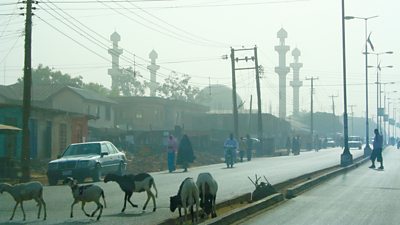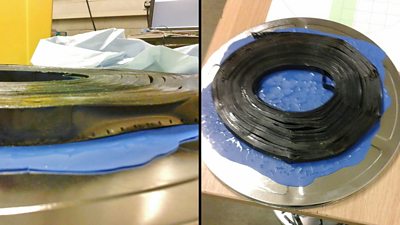A regular TV tradition at this time of year is the repeat of the Morecambe and Wise Christmas specials and 2017 is no exception - there is even a .
We thought readers might enjoy a good tale of some work we're involved with - to recover an episode of the comedy duo's TV series that was previously considered 'lost'. It involves some pretty advanced tech development work - a 'diseased' film, a trip to Nigeria, dentistry, lasers, X-ray tomography, algorithms and some goo... Television archiving expert Charles Norton writes about his involvement with the work in the first of this three part series.

In 1968, ITV lost Morecambe and Wise.
The famous comedy duo‘s contract with Lew Grade’s ATV company came up for renewal in early 1968 but . The reason (at least officially) was that they wanted to start making programmes in colour. In 1968, only one television channel was regularly broadcasting colour programmes in Britain – ���˿��� 2.
So, the comics changed networks and were contracted for the first seven recording sessions of a new ���˿��� series on 7th June 1968. A few weeks later, according to official ���˿��� accident reports, on his very first day in the studio, Eric Morecambe cut the fourth finger of his right hand, whilst playing the slide-trombone in a rehearsal of a musical sketch - a sketch that has until very recently been lost to the ���˿��� archives. A lot more on that later...
The first episode of ���˿��� 2’s Morecambe and Wise Show was screened at ten past eight on Monday 2nd September 1968.
Sadly however, the ���˿��� never formally archived that very first season of 'The Morecambe and Wise Show'. Although difficult to understand from a modern perspective, most UK television networks gave little thought to permanent archiving in the 1960s. At a time before the advent of video exploitation (DVDs, iPlayer etc.), bodies like the ���˿��� saw little purpose in maintaining a large and expensive collection of programming, merely for the sake of posterity.
Long-standing agreements with UK talent and musicians unions made it difficult too. Most UK television programmes were only ever contracted for one domestic repeat broadcast and so once a programme had been repeated once, there was often considered to be no point in further retaining the transmission master. It’s purpose had been served.
Each episode of 'The Morecambe and Wise Show' was repeated on ���˿���1 within the same week of its initial transmission. And so, it used up its contracted repeat potential very quickly. The master tapes would be returned to the engineering department and unless a programme retention form was issued by the production office, the tape would then be eventually cleared for wiping and then recorded over with a new programme. That new programme would then be wiped and recorded over and so the cycle would continue until the tape wore out completely and was discarded. At a time when videotape stock was very expensive, this recycling was viewed as a very necessary economy.
There was only one possible life-line for programmes that had gone through this process. Even after its master-tape had been erased, a programme might still survive if it was selected for a repeat broadcast overseas.
At around the time of broadcast, many ���˿��� programmes would be copied to 16mm black and white film – via a process called .
Telerecording involved a master-tape being played out to a special flat cathode ray tube screen. A 16mm film camera was pointed at this screen and as the programme was shown on the screen, it was filmed with the camera. These film recordings were not generally made for UK consumption, but rather for the purposes of international syndication. Virtually all countries were able to play out programmes from 16mm film and it became the format of choice for the marketing of ���˿��� programmes overseas.

Early ���˿��� telerecording equipment was exceptionally crude and it was not unknown for some unwary insect to be captured sitting in the middle of the TV screen, during the recording process – forever burnt into that programme’s film recording. However, by the late 60s, the process had been refined significantly and was now relatively sophisticated. Techniques such as ‘spot-wobble’, fed a sine wave through the output, in order to slightly fog the horizontal line-structure of the 625 line video playback – producing a less obviously grainy image. And an enclosed housing prevented dust and insects from landing on the glass. The eventual 'stored-field' system of telerecording was capable of capturing a full 575 lines of active image information.
As almost all territories (outside of Britain, Germany and America) had yet to introduce colour television, these 16mm international prints were almost always recorded to black and white film. A special notch-filter was designed to filter out unwanted interference from any latent chroma sub-carrier in the colour master.
Rather than have multiple film prints created for each episode, it was routine by this time for ���˿��� Enterprises to employ a money-saving ‘bicycling’ system for transmission prints of its programmes. First, a print would be struck in London and would be sent to a TV network in a particular country – for example, Australia’s ABC. Later, perhaps another country would then purchase the screening rights – for example, NZBC in New Zealand. ���˿��� Enterprises would then instruct ABC in Australia to send their prints to NZBC in New Zealand, when they were finished with them.
When the episodes had been screened by everyone who wanted them, the last network in the chain would be asked to send the film back to the ���˿���. By this stage, the films were getting very dog-eared indeed, having passed through the hands of numerous television networks and having been broadcast many times. Sometimes rather than ask for the films back, ���˿��� Enterprises would ask for the films to be destroyed (to stop them being screened without permission). A certificate of destruction would be sent to London to confirm this.
By the late 1970s, prints of the first series of ‘The Morecambe and Wise Show’ had found themselves in the film stores of RKTV - a broadcaster in Nigeria. By now, colour television was becoming firmly established and very few people were interested in buying black and white film recordings. Consequently, ���˿��� Enterprises ceased to see any need to retain their own black and white negatives of ‘The Morecambe and Wise Show’ and so the films were taken off the shelf and sent off to landfill. Over 100 'Doctor Who' masters also followed them into the skip too. The ���˿��� now no longer held any recordings of the first series of ‘The Morecambe and Wise Show’. They were gone – seemingly forever. Or so we had assumed.
What happened next is difficult to chart. However, it seems that (for some reason) the staff at the RKTV archive in Nigeria held onto their Morecambe and Wise prints. They contractually shouldn't have done, but they did... Thankfully.
Decades went by. Then in 2012, a freelance film researcher called Philip Morris gained rare access to the RKTV vaults to have a look around. He’d been granted permission (by ) to hunt for any ���˿��� television programmes that might still be in RKTV’s possession. Anything he found, he would bring back to the UK.

Image of Jos, Nigeria (cropped) by on Flickr, .
The RKTV vault was a hot, poorly ventilated outbuilding in a small semi-rural settlement called . A bakingly hot plateau in the heart of Nigeria, the area suffers from high-humidity in the rainy season and a desert of drought at all other times. The often poor state of the films in the archive reflects these harsh conditions.
Philip Morris’ trip to the RKTV vault was a very worthwhile one. RKTV held unique film recordings of various ���˿��� programmes that were not known to exist anywhere else in the world. Among the cracked and sweaty film cans, were otherwise lost episodes of ‘Doctor Who’, ‘The Sky at Night’ and finally also ‘The Morecambe and Wise Show’.On a single 16mm film spool, RKTV had the earliest surviving episode (episode 2) of ‘The Morecambe and Wise Show’ and the earliest surviving footage of the double act working for the ���˿���. It was an important find.
However, there was a problem.
The Nigerian Morecambe and Wise film was in an advanced state of decay. The episode was on a form of film stock that isn’t really used anymore and it was suffering from something called ‘tri-acetate film base degradation’ – a truly horrifying film ‘disease’ that can cause film to just rot away to nothing.
The 16mm format onto which the ���˿��� printed its film recordings of ‘The Morecambe and Wise Show’ has virtually always been an acetate based stock. If kept in humid conditions for any prolonged period of time, the tri-acetate can begin to break down at a chemical level. And once this process starts, it cannot be stopped. At a molecular level, as the plastic increases in temperature, the acetate breaks down releasing a vapour of acetic acid. This vapour is of no material danger to humans – it is chemically similar to the kind of thing most people splash on their fish and chips. However, it's positively lethal if you happen to be a roll of film.

The acetic acid further breaks down the plastic by eating away at the film, through general acidic corrosion. This then releases more acid and the cycle goes on until there is no more acetate left to be converted. Molecular sieves and refrigeration can slow the process down, but they won’t stop it.
The roll of film has become sticky, thinner and lacking in overall structural integrity. In fact, every layer of film on the Morecambe and Wise roll has now permanently fused itself with every adjacent layer of film so instead of having a roll of movie film, we now have a lump of plastic. All of the pictures that make up this episode are sealed inside that lump of plastic. And as the film is sitting in a self-sustaining vapour of corrosive acid, it just gets worse and worse.
Eventually, this priceless roll of film will turn into soup.
Both the ���˿��� archives and the BFI film archives cast an eye over the film, but concluded that nothing could be done with it. The BFI actually recommended its destruction as the sheer quantity of acid vapour being produced by the film effectively made it a hazard to other rolls in the BFI’s collection. The risk of ‘infection’ was just too high.
Imagine painting a beautiful picture on one sheet of glass. However, instead of painting that picture with paint, you use Marmite. Now put a second sheet of glass on top of this - you have a lovely image sandwiched between the two sheets of glass. However, if you were to pull those two pieces of glass apart, the image would be destroyed beyond recognition. That is what we have with Morecambe and Wise – a Marmite sandwich. And we only want the Marmite.
Happily, a producer at ���˿��� Birmingham (Paul Vanezis) stepped in and saved the film from oblivion. He investigated the feasibility of chemical treatment for the print, which ultimately was impractical. The film was so much of a mush, that immersion in any liquid would simply wash away any remaining picture from the surface of the film. Loathe to dispose of the film, he stored it at his home for about a year in his fridge, until late 2014, when I collected it from him.
My idea was to try something a little bit radical and something entirely new in terms of film restoration. In 2012, archaeologists working with the embarked on a project to examine an artefact called the Antikythera mechanism – an ancient Greek navigational calculator from the time of Archimedes. They brought in Roger Hadland at X-Tek imaging to help them . X-Tek and their team took the novel approach of dissecting the piece from the inside outward, using X-ray Tomography to look at the inner workings of the device, without ever actually breaking the item apart.
What if it was possible to use an X-ray scanner to lock onto the metal content within the film emulsion layer and turn it into a visible light image? Could we scan the film without unrolling it? Without even touching it?
Any roll of film is essentially just a strip of plastic with a picture printed onto one side of it and the image layer is called the emulsion layer. The key component of black and white emulsion is silver oxide - the metal content of which is, in fact, very high. So high that a hundred years ago they used to melt films down for scrap metal.
In theory, this high silver content would work well for X-ray Tomography. All tomographic methods look for the difference in X-Ray opacity between two substances. In the case of Morecambe and Wise, we are looking at the difference between the translucent plastic layer and the high metal content in the emulsion layer. If the theory was sound (which it indeed did turn out to be) then the silver content should light up in the scan.
Nobody had ever done this before. The idea was completely untested. And my total lack of any working knowledge of the technology gave me no confidence that it ever even could be tested.
I canvassed the opinion of a number of experts, with a much better grasp of the physics. The general consensus of that opinion was that the idea was completely impossible (and maybe a little bit crackers). There would simply never be a way of getting a sensitive enough response to make out the fine detail in a 16mm film frame. It was just impossible.
I sounded out and at who had been recommended to me, due to their cutting edge work developing a form of extremely high sensitivity X-ray Microtomography. It had been perfected for the examination of water-damaged documents.
After much discussion Graham generally concurred that scanning a roll of film with X-rays was probably impossible.
And so naturally, he got to work on it almost immediately.
- Part 2 of this series looks at how images were extracted from the film after it had been X-rayed and lasered into bits!
